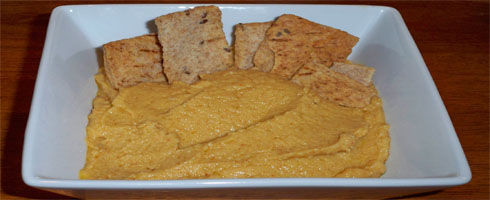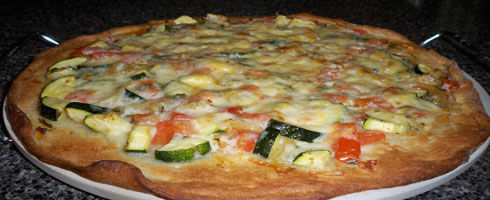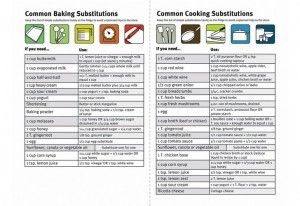This is in the format of: <Recipe calls for this, but you don’t have it>:<Substitute with this instead>
Cooking Substitutions:
Bacon, 1 slice, crisp-cooked, crumbled: 1 tablespoon cooked bacon pieces
Baking powder, 1 teaspoon: 1/2 teaspoon cream of tartar plus 1/4 teaspoon baking soda
Balsamic vinegar, 1 tablespoon: 1 tablespoon cider vinegar or red wine vinegar plus 1/2 teaspoon sugar
Bourbon or Sherry, 2 tablespoons: 1 to 2 teaspoons vanilla extract. Add water, white grape juice, or apple juice to get the specified amount of liquid (when the liquid amount is crucial).
Bread crumbs, fine dry 1/4 cup: 3/4 cup soft bread crumbs, or 1/4 cup cracker crumbs, or 1/4 cup cornflake crumbs
Broth, beef or chicken, 1 cup: 1 teaspoon or 1 cube instant beef or chicken bouillon plus 1 cup hot water
Butter, 1 cup: 1 cup shortening plus 1/4 teaspoon salt, if desired
Buttermilk, 1 cup: 1 tablespoon lemon juice or vinegar plus enough milk to make 1 cup (let stand 5 minutes before using) or 1 cup plain yogurt.
Chocolate, semisweet, 1 ounce: 3 tablespoons semisweet chocolate pieces, or 1 ounce unsweetened chocolate plus 1 tablespoon granulated sugar, or 1 tablespoon unsweetened cocoa powder plus 2 teaspoons sugar and 2 teaspoons shortening.
Chocolate, sweet baking, 4 ounces: 1/4 cup unsweetened cocoa powder plus 1/3 cup granulated sugar and 3 tablespoons shortening
Chocolate, unsweetened, 1 ounce: 3 tablespoons unsweetened cocoa powder plus 1 tablespoon cooking oil or shortening, melted.
Cornstarch, 1 tablespoon (for thickening): 2 tablespoons all-purpose flour
Corn syrup (light), 1 cup: 1 cup granulated sugar plus 1/4 cup water
Egg, 1 whole: 2 egg whites, or 2 egg yolks, or 1/4 cup refrigerated or frozen egg product, thawed
Flour, cake, 1 cup: 1 cup minus 2 tablespoons all-purpose flour
Flour, self-rising, 1 cup: 1 cup all-purpose flour plus 1 teaspoon baking powder, 1/2 teaspoon salt, and 1/4 teaspoon baking soda.
Garlic, 1 clove: 1/2 teaspoon bottled minced garlic or 1/8 teaspoon garlic powder
Ginger, grated fresh, 1 teaspoon: 1/4 teaspoon ground ginger
Half-and-half or light cream, 1 cup: 1 tablespoon melted butter or margarine plus enough whole milk to make 1 cup
Lemon (Juice of one Lemon): 2-3 tablespoons of lemon juice equals juice of one lemon
Molasses, 1 cup: 1 cup honey
Mustard, dry, 1 teaspoon: 1 tablespoon prepared (in cooked mixtures)
Mustard, yellow, 1 tablespoon: 1/2 teaspoon dry mustard plus 2 teaspoons vinegar
Onion, chopped, 1/2 cup: 2 tablespoons dried minced onion or 1/2 teaspoon onion powder
Sour cream, dairy, 1 cup: 1 cup plain yorgurt
Sugar, granulated, 1 cup: 1 cup packed brown sugar or 2 cups sifted powdered sugar
Sugar, brown, 1 cup packed: 1 cup granulated sugar plus 2 tablespoons molasses
Tomato juice, 1 cup: 1/2 cup tomato sauce plus 1/2 cup water
Tomato sauce, 2 cups: 3/4 cup tomato paste plus 1 cup water
Vanilla bean, 1 whole: 2 teaspoons vanilla extract
Wine, red, 1 cup: 1 cup beef or chicken broth in savory recipes; cranberry juice in desserts
Wine, white, 1 cup: 1 cup chicken broth in savory recipes; apple juice or white grape juice in desserts
Yeast, active dry, 1 package: about 2 1/4 teaspoons active dry yeast
Seasonings:
Apple pie spice, 1 teaspoon: 1/2 teaspoon ground cinnamon plus 1/4 teaspoon ground nutmeg, 1/8 teaspoon ground allspice, and dash ground cloves or ginger
Cajun seasoning, 1 tablespoon: 1/2 teaspoon white pepper, 1/2 teaspoon garlic powder, 1/2 teaspoon onion powder, 1/2 teaspoon ground red pepper, 1/2 teaspoon paprika, and 1/2 teaspoon black pepper
Herbs, snipped fresh, 1 teaspoon: 1/2 to 1 teaspoon dried herb, crushed, or 1/2 teaspoon ground herb
Poultry seasoning, 1 tablespoon: 3/4 teaspoon dried sage, crushed, plus 1/4 teaspoon dried thyme or marjoram, crushed
Pumpkin pie spice, 1 teaspoon: 1/2 teaspoon ground cinnamon plus 1/4 teaspoon ground ginger, 1/4 teaspoon ground allspice, and 1/8 teaspoon ground nutmeg




